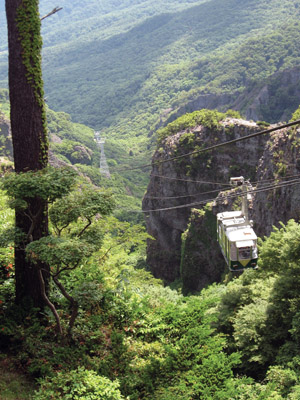Shodoshima

“I was a stranger in parts where strangers seldom came.”
–Donald Richie, The Inland Sea
|
In 1971, Donald Richie fretted that Shodo-shima, second-largest of the islands of the Inland Sea, would soon be overrun by bridge-building Honshu residents who would obliterate the “attractions of this attractively backward place” and replace them with the crowded, colorless urban sameness of Tokyo’s metropolitan areas. Nearly four decades later, the visitor to Shodo can happily report that Richie’s lament was premature. Sure, the main port of Tonosho has a garish pachinko arcade and a clutch of omiyage shops selling the usual assortments of kitsch. But ride a bicycle ten minutes in any direction and you’ll find yourself cycling back in time through picturesque seascapes, olive groves, and soaring jagged-toothed mountain peaks. Shodo-shima is perhaps most famous as the setting for the award-winning 1954 film “Twenty-Four Eyes,” based on the novel of the same name by native daughter Sakae Tsuboi. Fans of the movie will be pleased to see that despite some development, the landscape around the Tanoura village school featured in the film has changed little. The center of Shodo-shima is dominated by Kanka-kei, one of Japan’s “Three Most Beautiful Gorges.” The gorge attracts legions of tourists in the autumn for its beautiful colors, but hikers in other seasons can enjoy the precipitous lookouts in contemplative tranquility. (A ¥1250 roundtrip cable car journey through the gorge is available for visitors who like to enjoy their scenery without strain.) Shodoshima is also one of Japan’s major areas of olive oil production. Olive afficionados may be disappointed that whole olives are mostly unavailable, but an olive-flavored soft cream after a hard day’s bike ride makes a welcome treat! A new hot spring complex on the south coast celebrates all things olive-related. Elsewhere on the island, pilgrims can perform a shorter version of the 88-Temple Shikoku walk. Near Tonosho, three islets join together at low tide to form “Angel Road,” a beautiful stretch of tidepools and pine-clad sandstone cliffs. Shodoshima can be reached via an hour-long ferry ride from Takamatsu or Okayama; public transportation on the island is infrequent, but rental cars are cheap and passing drivers are hitchhiker-friendly. Because of Shodoshima’s relative isolation, it’s advisable to stay the night at one of the island’s many minishiku (traditional inns), which serve delicious evening meals of locally-made somen and fresh seafood. www.shodoshima.or.jp |
「よそ者などほとんど来ないような土地で私もちょっとだけよそ者気分を味わった」 1971年、ドナルド・リッチーは瀬戸内海で2番目に大きな島である小豆島の将来を憂えていた。自然が豊かに残るこの島が本州と橋で結ばれ、本州から人がどんどん入ってきて開発が進み、島の魅力が無くなってしまうのではないかと。そして約40年がたった今、島を訪れる人たちはリッチーの心配が取り越し苦労であったことを知り、豊かな自然が今でも残るこの島の魅力を満喫している。 島の主要港である土庄港にはけばけばしい装飾のパチンコ屋があるし、軒を連ねる土産物屋がごちゃごちゃと商品を並べているけれど、自転車で10分も走れば別世界、絵画を楽しんでいるような光景に包まれる。美しい海、オリーブの木立、そびえる山々・・・ 小豆島出身の小説家、壺井栄の作品「二十四の瞳」の舞台になり、同タイトルで映画化もされたことで小豆島はその名前がよく知られるようになった。映画のセットで使われた旧田浦尋常小学校付近の風景は映画が撮影された当時とあまり変わっておらず、ファンの目を楽しませている。 島の中央には日本三大奇勝のひとつに数えられる「寒霞渓」(かんかけい)がある。紅葉や新緑の景色が圧巻だが、その他のシーズンでも奇岩、岸壁がそびえる光景に目を奪われる。(1250円でケーブルカーに乗って渓谷の風景を楽しむことも可能) また小豆島は日本では珍しくオリーブ・オイルの生産でも知られる。残念なことに生のオリーブは現在ほとんど手に入らないが、オリーブ味のソフトクリームなどは一日中自転車で走り回った後のご褒美には最高。島の南部に新しく出来た温泉施設にはオリーブを利用したもの、オリーブに因んだものなどがいろいろある。また、四国八十八箇所のミニ巡礼コースとして小豆島八十八箇所があり、島を訪れる巡礼者も多い。土庄町近くには潮の干満によって現れたり消えたりする「エンジェル・ロード」など、恋人たちにも人気のスポットもある。 小豆島への交通手段は、高松港、新岡山港などからフェリーで約1時間、島内での公共交通手段は限られるが、レンタカーは安いし、ヒッチハイクしても皆気軽に乗せてくれる。自然豊かな小豆島での宿泊はやはり民宿がおすすめだ。民宿に泊まって特産品の素麺や、新鮮な魚介類を使った豪華な食事を楽しもう。 サイト: www.shodoshima.or.jp |








